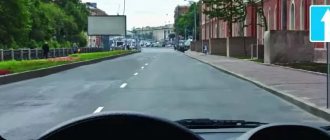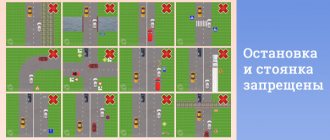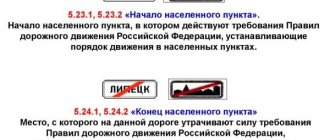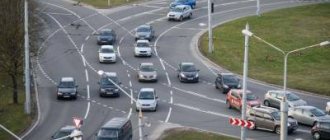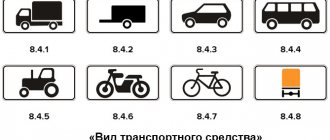Navigating the rules can sometimes be quite difficult.
It’s good if road signs tell you what you can and cannot do on a given section of the road.
What to do if behavior on the road is not determined by signs?
It is proposed to remember the not so simple part of the traffic rules - stopping on the bridge, specify the area of the ban and remind about exceptions to the rules.
Is stopping on the bridge allowed?
So, is it possible to stop on the bridge? Before discussing possible bans, it is proposed to differentiate between bridges, overpasses and overpasses.
A bridge is an artificial structure that is erected over rivers and other water barriers; an overpass and overpass are intended to pass over land objects.
You cannot stop on artificial structures designed to pass over a water obstacle.
This prohibition applies to vehicles crossing the bridge if the number of vehicle lanes in a particular direction is less than three.
It is strictly forbidden to stop on bridge structures not on a whim, but due to a number of objective factors. The most important of them are:
- limited space;
- increased pressure on bridge supports.
They are united by the danger of placing a large number of vehicles on the road section in question.
Violation of the rule entails negative consequences for the wallet and psyche of the motorist. Penalties for parking on the bridge include payment of 2,000 rubles. In Moscow and St. Petersburg the punishment is harsher. There you will have to pay 3000 rubles.
In addition, if the rules are violated, the following measures are applied:
- detention of a vehicle;
- placing the offender's car in a specialized paid parking lot.
There are exceptions to the rule. Knowing about them, you can prevent a number of problems associated with non-compliance with traffic rules.
Responsibility for wrong stopping
Such violations occur quite often. In most cities there are a lot of cars, so drivers sometimes ignore the rules and park the car where there is free space. If such illegal actions are detected, the car owner can expect the following measures:
| Composition of the offense | Code of Administrative Offenses of the Russian Federation | Punishment |
| The current parking or stopping rules have been violated, namely: - the car is parked at a pedestrian crossing, on tram tracks; - the car is parked in places where public transport stops, or facilities for the disabled; - or the stop created an obstacle to other drivers and other violations. | Art. 12.19 | 500 – 5,000 rubles (depending on the type of offense) For drivers in Moscow and St. Petersburg, the fine amount will be more significant. |
| Prohibited parking or stopping at a railway crossing | Part 1 Article 12.10 | They may impose a fine of 1,000 rubles, or the driver will be deprived of his license for 3-6 months |
Outside populated areas, stopping on the left side of the road is prohibited. This tells us clause 12.1 of the traffic rules, which states that such a maneuver is permitted only within the city. The penalty is determined in accordance with Art. 12.19 Code of Administrative Offenses of the Russian Federation.
If the driver still wants to stop on the left side, then it is better to make a U-turn (provided that there are no prohibiting signs or markings) and park the car on the other side.
Stop and park on the left side of the road. Violation or not?
When is stopping allowed?
It is proposed to consider in detail the situations when a motorist can interrupt the movement.
You are allowed to stop in the following cases:
- in front of the bridge;
- after the bridge;
- on a bridge if certain requirements for the roadway are met and there are no prohibiting signs;
- in case of sudden problems with the car or its driver, forcing you to stop in the interests of traffic safety;
- at the request of the inspector, which is a priority on the road.
Interestingly, the rules do not regulate the beginning and end of the bridge in any way. There are no special signs that would help to unambiguously determine the length of this structure. The traffic regulations do not provide for the installation of technical means warning of entry onto the bridge. There is only one way out: the car enthusiast will have to solve this problem on his own.
In search of an answer to the question posed, one has to turn to regulatory documents from other areas. The current GOST 33178-2014 defines the length of the bridge as “the distance along the axis of the bridge between the ends of the abutments or other visible structural elements of the abutment or span adjacent to the embankments of the inlets,” and emphasizes that it is measured without taking into account the transition slabs. This difficult formulation does not make the life of a car enthusiast any easier.
The boundaries of an artificial structure can be considered its foundations, that is, the supports located along the edges. Indirect evidence of entry to the bridge is a sign with the name of the bridge or the river it crosses. The appearance of characteristic enclosing elements is considered as the boundaries of the bridge.
The beginning of the bridge construction is indicated by a rise. All this leads to a variety of subjective perceptions of the same situation by different road users and entails the emergence of a conflict of interests between motorists and authorities.
Since there are no clear instructions regarding the definition of the boundaries of a bridge structure in the traffic rules, the final word remains with a specific inspector or judge.
Signs
A special “Bridge” sign has not yet been created.
Nevertheless, the traffic rules consider technical means that prompt the driver about driving on the bridge and thereby warn about the corresponding restrictions. It is suggested that you pay attention to them.
So, the appearance of the following signs indicates that a car is entering the bridge:
- 3.11 “Weight limit” means a ban on the movement of vehicles with a weight exceeding the specified one.
- 3.12 “Limitation of mass per axle of a vehicle” does not allow further movement of vehicles whose actual mass per axle exceeds that prescribed by the sign.
- 1.9 “Drawable bridge” is installed in front of bridge structures that have a movable span to ensure the passage of ships.
- 1.29 “Crosswind” is located in front of sections of roads passing over bridges, etc., where strong crosswinds are possible.
The first two points are represented by technical traffic safety means from the prohibitive category.
They are a circle with a red border around the perimeter. The effect of these signs begins right from the place where they are installed.
The last two points include warning signs. They look like triangles with a thick red border around the perimeter.
Information about the nature of the possible danger is schematically depicted on a white background. Knowing the distance from the sign installation to the beginning of the dangerous section, the driver will be able to determine the moment of entering the bridge.
On the one hand, such a number of signs indirectly indicating the entrance to the bridge does not make life easier for the motorist. On the other hand, the absence of these signals will help prove in court that the stop was not made on the bridge, therefore, the rules were not violated.
Video on the topic
Dear readers, the information in the article may be out of date, take advantage of a free consultation by calling: Moscow +7
, St. Petersburg
+7 (812) 317-70-86
or via the feedback form below.
12.1. Stopping and parking of vehicles is permitted on the right side of the road on the side of the road, and in its absence - on the roadway at its edge and in the cases established by paragraph 12.2 of the Rules - on the sidewalk.
Read more: Yellow markings at a bus stop
On the left side of the road, stopping and parking are permitted in populated areas on roads with one lane for each direction without tram tracks in the middle and on one-way roads (trucks with a permissible maximum weight of more than 3.5 tons are allowed on the left side of one-way roads only stopping for loading or unloading).
12.2. It is allowed to park the vehicle in one row parallel to the edge of the roadway. Two-wheeled vehicles without a side trailer may be parked in two rows.
The method of parking a vehicle (parking lot) is determined by sign 6.4 and road marking lines, sign 6.4 with one of the signs 8.6.1 - 8.6.9 and road marking lines or without them.
The combination of sign 6.4 with one of the plates 8.6.4 - 8.6.9, as well as road marking lines, allows the vehicle to be positioned at an angle to the edge of the roadway if the configuration (local widening) of the roadway allows such an arrangement.
Parking on the edge of the sidewalk bordering the roadway is permitted only for cars, motorcycles, mopeds and bicycles in places marked with sign 6.4 with one of the signs 8.4.7, 8.6.2, 8.6.3, 8.6.6 - 8.6.9.
12.3. Parking for the purpose of long-term rest, overnight stay, etc. outside a populated area is permitted only in designated areas or off the road.
12.4. Stopping is prohibited:
- on tram tracks, as well as in the immediate vicinity of them, if this creates interference with the movement of trams;
- at railway crossings, in tunnels, as well as on overpasses, bridges, overpasses (if there are less than three lanes for traffic in a given direction) and under them;
- in places where the distance between a solid marking line (except indicating the edge of the roadway), a dividing strip or the opposite edge of the roadway and a stopped vehicle is less than 3 m;
- at pedestrian crossings and closer than 5 m in front of them;
- on the roadway near dangerous turns and convex breaks in the longitudinal profile of the road when the visibility of the road is less than 100 m in at least one direction;
- at the intersection of roadways and closer than 5 m from the edge of the roadway being crossed, with the exception of the side opposite the side passage of three-way intersections (crossroads) that have a continuous marking line or dividing strip;
12.5. Parking is prohibited:
- in places where stopping is prohibited;
- outside populated areas on the carriageway of roads marked with sign 2.1;
- closer than 50 m from railway crossings.
12.6. If forced to stop in places where stopping is prohibited, the driver must take all possible measures to remove the vehicle from these places.
12.7. It is prohibited to open vehicle doors if this will interfere with other road users.
12.8. The driver may leave his seat or leave the vehicle if he has taken the necessary measures to prevent spontaneous movement of the vehicle or its use in the absence of the driver.
It is prohibited to leave a child under 7 years of age in a vehicle while it is parked in the absence of an adult.
Number of lanes
Many rules have exceptions. There is also a nuance to the ban on parking on bridges.
Two lanes in one direction clearly prohibit stopping at the structure.
The presence of three lanes when driving in one direction allows for a short stop.
There is logic in this decision. By occupying one of the available lanes in two-lane traffic, a vehicle will inevitably create an obstacle to the movement of other vehicles on a narrow bridge.
3 lanes help to avoid traffic interference; in such cases, stopping on the bridge is permitted. Cars stopped on such bridges do not prevent other cars from changing their position in space and do not create prerequisites for testing the bridge structure to its ultimate strength.
Traffic restrictions that exist on narrow bridges do not matter on three-lane river crossings.
Signs and markings significantly simplify the life of a motorist, telling them what can be done on a particular section of the road and what is strictly prohibited. The case under consideration seems more complex, since the prohibition is sometimes not indicated in any way and at the right time must emerge from the depths of the driver’s memory.
Fines for violating traffic rules
Depending on which paragraph of the Rules is violated by the motorist, one or another sanction will follow in accordance with the current edition of the Administrative Code:
- Turning around on an overpass or overpass, or in places located under them. Failure to comply with clause 8.11. of the Rules will entail a sanction in the form of a fine of 500 rubles in accordance with Part 2 of Art. 12.14. Code of Administrative Offences. The fine will be 250 rubles if paid within 20 days after the decision is issued.
- Turn around on a bridge located within the highway marked with sign 5.1. The fine for this violation is already 5 times greater - 2500 rubles (Part 3 of Article 12.11 of the Administrative Code).
- Moving backwards. The sanction is exactly the same as for a reversal - 500 rubles based on Part 2 of Art. 12.14. Code of Administrative Offences.
- Overtaking. The penalty is the same as for overtaking across a continuous road on other sections of the road, if it (overtaking) is prohibited in accordance with any paragraph of the Rules:
- or a fine of 5,000 rubles;
- or revocation of a driver's license for a period of 4 to 6 months.
If the traffic police inspector chooses deprivation of rights, the specific period of deprivation will be established by the court (Article 23.1 of the Administrative Code).
If you overtake on the bridge again (once again within 12 months - Article 4.6 of the Code of Administrative Offenses), then the sanctions will be much harsher - no alternative deprivation of rights for a period of 1 year. An exception is if repeated overtaking is recorded by a camera - then a fine of 5000 is imposed.
- Stopping or parking on an overpass or overpass. The punishment depends on the offense:
- if stopping or parking resulted in interference with the driving of other vehicles, sanctions will be imposed under Part 4 of Art. 12.19. Administrative Code - 2,000 rubles, and stopping or parking on a bridge that creates interference, if the bridge is located within the boundaries of a city of federal significance, is punishable by an increased fine of 3,000 rubles (Part 6, Article 12.19 of the Administrative Code);
- if the inspector did not notice the creation of obstacles to traffic, the punishment is imposed in accordance with Part 1 of Art. 12.19. Code of Administrative Offenses – warning or 500 rubles.
All traffic fines presented can be paid with a 50% discount.
- Violation of the established speed limit on the bridge. Responsibility is the same as for speeding in other situations, that is:
| How much was the speed exceeded from the maximum permitted, km/h | Types of punishment according to Art. 12.9. Code of Administrative Offenses |
| From 20 to 40 | 0.5 thousand rubles |
| From 40 to 60 | From 1 to 1.5 thousand. |
| Repeated from 40 to 60 | From 2 to 2.5 thousand. |
| From 60 to 80 | Or from 2 to 2.5 thousand, or cancellation of the temporary residence permit from 4 to 6 months |
| Repeated from 60 to 80 | Deprivation of rights for 1 year |
| From 80 and more | 5 thousand or cancellation of the license for 6 months |
| Repeated from 80 and over | Imprisonment for 1 year |
- Driving in an undesignated lane. If the driver takes, for example, outside a populated area on a bridge the left lane when the right one is free, sanctions will apply under Part 1 of Art. 12.15. Code of Administrative Offences—fine 1,500 rubles.
- The turn signal does not turn on when changing lanes. Responsibility will be under Part 1 of Art. 12.14. Code of Administrative Offenses – warning or 500 rubles.
So, in the Rules there is no definition of such concepts as a bridge, overpass, overpass, although at various points there is a ban on performing certain maneuvers in these places.
A motorist can distinguish a bridge from other objects both visually and by the presence of vertical markings 2.1.1. – 2.1.3. and 2.2., as well as an information sign with the name of the river (lake, reservoir).
Where is stopping and parking of vehicles prohibited according to traffic regulations? Find the answer in the article: stopping and parking in traffic rules.
With prohibitory traffic rules signs.
Turning left according to traffic rules is discussed on this page.

